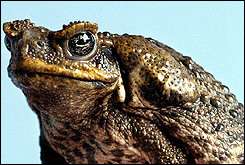Cane toads that move in lines most responsible for their deadly spread

(Phys.org) —How are cane toads taking over Australia with such alarming haste? New research from the University of Sydney offers new insight into the pervasiveness of one of the nation's most reviled pests.
Latest findings from a team led by Professor Rick Shine from the University's School of Biological Sciences shed light on how those at the frontline of cane toad invasions make more headway than their established counterparts, making them responsible for the species' seemingly unstoppable spread.
The findings build on research published last year which found that cane toads at the vanguard of invasions can move twice as quickly as those from established populations. These earlier findings explain why the cane toad population overall is now expanding at a rate of 55 kilometres a year. This is a more than five-fold increase over the rate of expansion when the species was introduced to Australia in 1935.
Published today in the Proceedings of the Royal Society B, these results reveal that toads at the front end of an invasion travel in straighter lines than established populations. They offer clues about how many invasive species' populations spread.
"The extent to which you move in a straight line - and therefore travel the greatest distance with the least amount of effort - is important," said co-author Dr Gregory Brown from the School of Biological Sciences. "Taking a straight trajectory can massively increase the distance you travel per day so the evolution of straighter paths might be a particularly effective way to achieve rapid dispersal."
The research studied the movements of cane toads in the Adelaide River, Northern Territory over a nine year period starting in 2005, when cane toads first arrived in that area. Vanguard toads were monitored with transmitters during the wet season, when they travel the greatest distances. Not only did the invasion-front toads move further and along straighter paths than toads arriving later, but the offspring of invasion-front toads inherited their parents' behavior.
"The offspring of parents on the invasion front moved in straighter lines than those of toads from long-colonised areas. We can conclude from this that the trait of travelling in a straight line can be inherited," Professor Shine said.
"These findings are worrying. They confirm that invasive animals can evolve quickly to move faster, which makes it even more difficult to manage the threat they pose to our native wildlife."
Cane toads were introduced to the north eastern coast of Australia to control pests in sugarcane plantations in 1935. Their spread is having a devastating impact on native species such as crocodiles, goannas and quolls, who eat the toads and are killed when by their powerful poisons. In some local populations more than 95 percent of these animals are killed within a few months of the toads' arrival.
More information: Gregory P. Brown, Benjamin L. Phillips, and Richard Shine. "The straight and narrow path: the evolution of straight-line dispersal at a cane toad invasion front." Proc. R. Soc. B November 22, 2014 281 1795 20141385; DOI: 10.1098/rspb.2014.1385 1471-2954
Journal information: Proceedings of the Royal Society B
Provided by University of Sydney




















